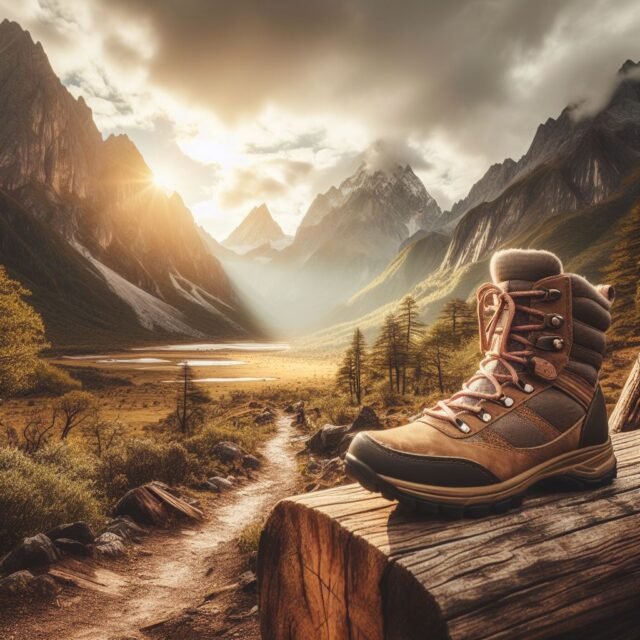Table of Contents
Conquer Any Trail: The Ultimate Guide to Women’s Hiking Boots and Shoes: From Mighty Merrells to Must-Have Must-Haves
Hitting the trails is an amazing way to connect with nature, get some exercise, and clear your head. But before you embark on your next adventure, make sure you’re properly equipped.
The right footwear is essential for a safe and enjoyable hike. This guide will equip you with all the knowledge you need to find the perfect women’s hiking boots or shoes and what to wear hiking for your next trek.
Choosing the Right Women’s Hiking Shoe for the Terrain:
- Women’s Hiking Shoes: Ideal for light day hikes on well-maintained trails. They provide good traction and breathability, but less ankle support than boots.
- Women’s Hiking Boots: Offer superior ankle support and protection for rugged terrain, backpacking trips, or uneven surfaces. Consider mid-height boots for most adventures, or opt for high-tops for extremely challenging hikes.
Popular Women’s Hiking Boots in 2025:
- Merrell Moab: A legendary name in hiking footwear, the Moab series offers a variety of boots and shoes for all types of trails. They’re known for their comfort, durability, and waterproof capabilities.
Merrell Moab Reviews: Women consistently rate the Merrell Moab highly for its supportive fit, excellent traction, and comfortable wearability on long hikes.

Here are some specific Merrell Moab boots to consider:
- Merrell Moab 3 Mid Waterproof: A versatile, all-purpose boot that provides great ankle support and waterproof protection for moderate trails.
- Merrell Moab 2 Vent Mid: A lighter option with a breathable mesh upper, perfect for warmer weather hikes.
Other Top Women’s Hiking Boot Brands:
-
- Columbia: Offers a wide range of hiking boots for different budgets and needs. Popular models include the Newton Ridge and the Fairbanks.
- Lowa: Renowned for their exceptional quality and durability. The Renegade GTX is a top choice for serious hikers.
- Keen: Known for their comfortable fit and innovative features. Look at the Targhee series for waterproof protection and great traction.
Important Features to Consider:
- Waterproofing: Look for a boot or shoe with a waterproof membrane like Gore-Tex to keep your feet dry in wet conditions.
- Ankle Support: Mid-height boots provide more stability, especially for uneven terrain or carrying a backpack.
- Traction: A good lug pattern on the outsole is essential for preventing slips and falls on loose surfaces like dirt, rocks, or mud.
- Comfort: Your boots should fit snugly but comfortably, with enough room to wiggle your toes. Consider trying them on with the socks you plan to wear hiking.

Ankle Support Smackdown: Women’s Hiking Boots vs. Shoes – Which One Reigns Supreme?
You’re staring down a glorious trail, the fresh mountain air tingling your nose. But a crucial question stands between you and adventure: boots or shoes?
Both have their strengths, and choosing the right one can make your hike a breeze or a blister-filled struggle. Let’s get down in the dirt and compare these two titans of the trail!
The Sturdy Steadfastness of Boots:
- Fortress for Your Feet: Hiking boots are like bodyguards for your ankles. Their higher collars provide stability and prevent nasty rolls on uneven terrain, especially when carrying a backpack.
- Conquer any Weather: Many boots boast waterproof membranes like Gore-Tex, keeping your feet dry when streams turn into puddles and sudden downpours threaten your adventure.
- Built to Last: Hiking boots are constructed with tougher materials like leather or synthetics, making them ideal for rugged hikes with loose rocks, roots, or scree.
But wait! Boots can be…
- Heavy Hitters: Compared to shoes, boots can feel heavy and bulky. This can be tiring on long hikes, especially for those who prioritize speed or agility.
- Break-in Blues: New boots often require a break-in period to prevent blisters. Don’t subject your feet to torture on your big hike – wear them around town beforehand!
- Less Breathable: Waterproof membranes can trap heat, making boots less ideal for hot weather hikes.
The Nimble Ninjas: Women’s Hiking Shoes
- Light on Their Feet: Hiking shoes are lighter and more flexible than boots, offering a more natural stride and less fatigue on long distances.
- Breathe Easy: Made with breathable mesh uppers, hiking shoes allow for better air circulation, keeping your feet cool and comfortable in warmer weather.
- Swift and Streamlined: Their lower profile gives you more freedom of movement, making them perfect for technical trails or fast-paced hikes.
However, shoes may not be the best choice for…
- Tricky Terrain: The lack of ankle support can be risky on uneven surfaces or when carrying a heavy pack.
- Soggy Situations: While some shoes offer water resistance, they generally won’t keep your feet dry in heavy rain or when fording streams.
- Rugged Trails: Their lighter construction may not hold up to the abuse of sharp rocks or debris.
So, who wins the battle?
It depends on your specific adventure! Here’s a quick cheat sheet:
- Choose Boots For: Rugged terrain, backpacking, ankle support needed, wet conditions.
- Choose Shoes For: Well-maintained trails, light hikes, warmer weather, prioritizing agility, outrunning bigfoot.
Remember, the perfect women’s hiking footwear is the one that keeps your feet happy and safe on your journey. So lace up with confidence and conquer the trails.
Women’s Hiking Pants:
- Choose breathable, quick-drying fabrics like nylon or convertible hiking pants that zip off into shorts.
- Look for features like articulated knees for freedom of movement, a water-repellent finish for light rain, and cargo pockets for storing essentials.

Women’s Hiking Footwear FAQ:
- Q: When should I wear boots vs. shoes?
- A: Boots are better for rough terrain, backpacking, or if you need extra ankle support. Shoes are a good option for light day hikes on well-maintained trails.
- Q: How much should I spend on hiking boots?
- A: Expect to spend anywhere from $100 to $300 on a good pair of hiking boots, depending on the brand, features, and materials.
- Q: How often should I replace my hiking boots?
- A: It depends on how often you hike and the terrain you cover. Generally, replace your boots when the tread wears down, the waterproofing fails, or the boots become uncomfortable.
People Also Ask:
- Are hiking boots good for everyday wear? While hiking boots can be comfortable, they may not be ideal for everyday wear due to their sturdiness.
- Can I break in my hiking boots before my hike? Absolutely! It’s important to wear your boots for short walks around town before your big hike to avoid blisters.
- What socks should I wear with hiking boots? Choose moisture-wicking socks made from wool or synthetic materials to keep your feet dry and comfortable.
With the right footwear and knowledge, you can conquer any trail with confidence.
So lace up your new women’s hiking boots or shoes, hit the path, and get ready to explore the beauty of nature!
Resources:
- American Hiking Society: Choosing the Right Hiking Boots https://americanhiking.org/resources/hiking-boots/
- Outdoor Tech Lab: Hiking Gear Guide & Resources https://www.outdoortechlab.com/hiking-guide-2024/
- National Parks Service: Hiking Safety Tips https://www.nps.gov/thingstodo/learn-about-hiking-safety.htm

Introducing JC – The Outdoor Gear Enthusiast and Tester behind Outdoor Tech Lab:
Dive into the exciting world of outdoor gear technology with JC, the founder and driving force behind Outdoor Tech Lab.
With a passion for backpacking, nature and a knack for outdoor gadgets, JC has embarked on a mission to help others explore the outdoors in smarter, safer, and more enjoyable ways.
Join us on the adventure as we explore the ever-evolving landscape of outdoor gear & technology.
Through insightful reviews, practical tips, testing and engaging stories, Outdoor Tech Lab is your one-stop shop for navigating the wild world of outdoor gadgets and gear in 2025 and beyond.




Leave a Reply